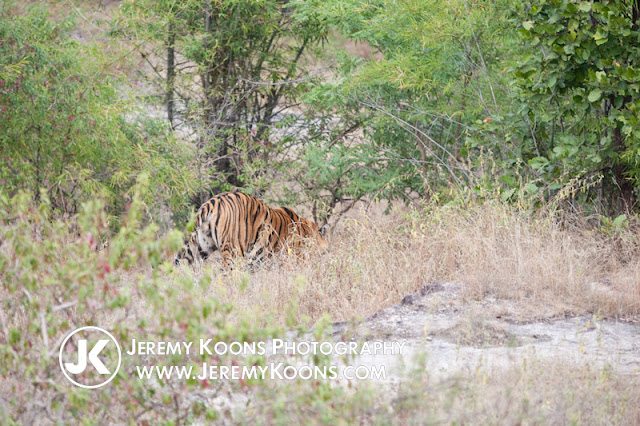Ready to see some tigers?
Be patient. Tiger sighting is an exercise in patience and luck. In India, you might call it Karma.
We spent close to 30 hours in the Nat'l Parks exclusively looking for tigers. (We saw many other great things along the way, but tiger was #1 on the shot list.)
I was fortunate to have 3 tiger sightings. One was at over 500 meters, which was exciting, but served mostly as a teaser. One was 'average' and the other was.... indescribable. (You'll see later.)
The following images describe an 'average' tiger sighting.
We travel with forest guards, expert trackers, and experienced naturalists.
We ride in open jeeps, from sunrise to sunset, with a lunch break during the heat of the day.
We search for signs of tiger, from scratches on the trees to pugmarks in the sand. Listening to the deer, monkeys, and birds is also a proven method.
Towards the end of the day.....
A tiger?
Oh $H!t, a TIGER!
Drat! Calm down and fix your exposure! Quick!
No! You missed it!
And.... he's gone.
Total time between the first shot and the last:
27 seconds.
Think about that. 2 days in a jeep for a 30 second view.
Also of note, there were over a dozen other jeeps at this sighting, which is right about 'average.'
The above sighting is a perfect example of what most people might see. Many people see less (as in,
zero tigers). A lucky few see more.
I am one of those lucky few.
The last photo was taken during a different sighting. (duh)
Comparing the two sightings:
Average = 1 tiger, walking through the brush, in crappy light, for under 30 seconds, with 50 other people frantically pointing and yelling, jostling for position.
My lucky sighting = 3 tigers, in full view, in gorgeous light, FOR 26 MINUTES!!!!, with only 7 other people quietly shooting and whispering, taking turns, waiting for pristine moments.
I will share more from this lucky sighting, but not yet.
You'll have to wait for it.
Be patient.
























































